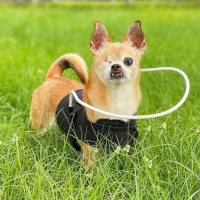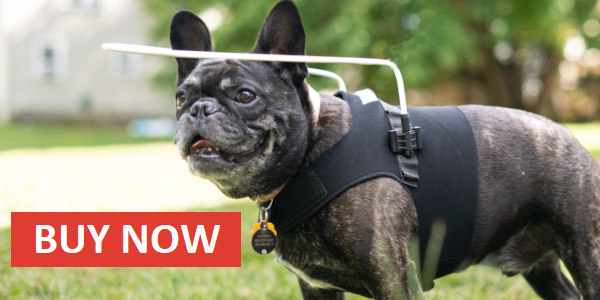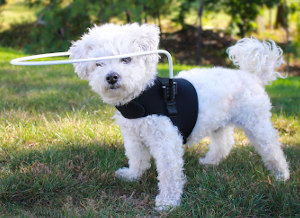- June 24, 2023
How To Help Your Blind Dog Adapt

Helping your newly blind or visually impaired dog adjust to their new way of life can be challenging. Watching your dog struggle as they try to move in what was once familiar territory is hard. As a pet owner, you feel lost watching your dog adjust, not understanding what’s happening to them. But there are simple actions that you can take to make sure that your blind dog thrives. How can you help your blind dog to adapt and feel safe?
How to Help A Blind Dog Adapt to Vision Loss
Here are some helpful tips on how you can make the adjustment a smooth one for your best friend:
1. Speak Calmly

Your voice can have a calming effect on your dog. A change in a pet’s eyesight can be disorienting. Blind pets startle easily; avoid making sudden movements or loud noises. Alert your pet that you’re nearby.
When your senior dog becomes confused or disoriented, speak soothingly to your dog. Let them know you are near and able to help them if they need it. Use your voice to guide them. If they’re asleep, gently blow in their face or lightly touch them to wake them.
2. Stick to Your Routine

As your dog adjusts to their new blindness, stick to its daily routine. If you always start your day with a walk around the neighborhood, keep doing it! These activities are familiar to your dog and help give them a sense of normalcy. A pet dealing with recent vision loss will have difficulty adjusting to any significant change in its routine. A regular schedule lets them know what time of day it is and what to expect next.
It’s important to remember that visually impaired and blind pets are relying solely on their other senses; they are going to be very reactive to the sounds around them. When you go for a walk, always keep your dog on a leash and safely by your side if they react to loud noise.
3. Use a Blind Dog Halo
Getting around is going to be difficult for a blind dog. Not only can losing their eyesight be confusing and scary for your dog, but it will take them time to adjust to their new life.
Ease the adjustment with the Blind Dog Halo, designed to help your dog gain confidence as they move around. Instead of bumping into the wall and tripping into furniture, the halo will provide a barrier between your dog and the object, helping to guide them away from hitting obstacles head-on safely.

4. Don’t Move Familiar Objects
Your pet has a great memory; keeping their food bowl in the same place will make it easier for them to find it when they’re hungry. Keep their favorite toys where they are. And try not to move your furniture! Rearranging your furniture can lead to your blind dog or cat bumping their head and may lead to injury.

To help blind pet adjust to their surroundings, walk your dog around the house. A guided tour helps them to navigate the house safely and helps blind pets to mentally “map” their surroundings. Slowly let them explore and refamiliarize themselves with their home one room at a time.
If you have a smaller dog, try not to pick them up too much. This can be very disorienting when you carry your dog around and place them in a new part of the house. Let them discover their surroundings slowly on their own and keep their favorite objects in familiar places.
5. Safety First
While your dog adjusts, keep them in a part of the house they find comforting; an area free of hazards is best. Use a pet gate to section off stairways or other parts of the house until your dog can master the entire house. Slowly open them to new parts of the house as they increase their confidence. When you’re not at home, consider crating your dog to give them a sense of security.
There are many ways that you can help your best friend adjust to their new circumstances, but the most important is to be patient. With a little time and effort your dog can live a full and happy life.
Related Articles:
Did we answer all your questions on “blind dog”?
Tags
What do you think?
Related Articles

New Puppy Checklist: Gear You’ll Need for Your New Dog
Getting a new puppy is really exciting, but before you welcome them home, it’s important to prepare your space for them. Since puppies need a

How Big Do Mini Poodles Get? Vet Reviewed Average Weight & Growth Chart – Dogster
The information is current and up-to-date in accordance with the latest veterinarian research. Learn more » When you buy a Miniature Poodle, you might not

Can Police Dogs Smell Nicotine? Vet Verified Facts & Info – Dogster
The information is current and up-to-date in accordance with the latest veterinarian research. Learn more » While cigarette sales have been declining steadily for decades,

How Old Is 5 in Dog Years? Vet-Approved Guide to Each Size of Dog – Dogster
The information is current and up-to-date in accordance with the latest veterinarian research. Learn more » A common method for calculating a dog’s age is

